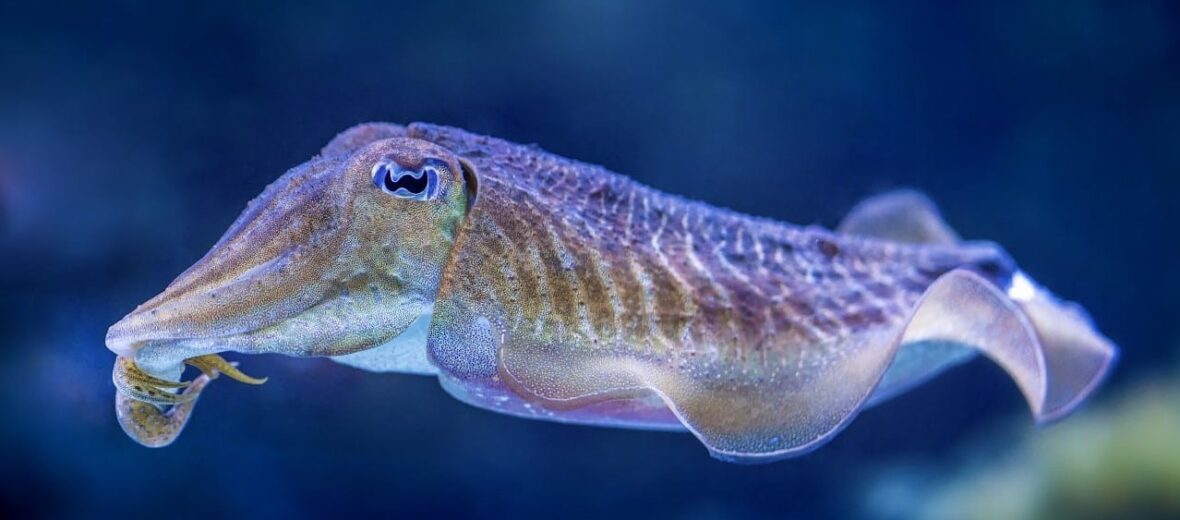
Cuttlefish are closely related to squids and octopuses. They are in the cephalopod family. Cephalopod means “head-foot”. There are 120 known species of cuttlefish. These cephalopods are very intelligent and have 1 of the biggest brain to body ratios of all known invertebrates. A testament to their intellect is that they can tell the difference between food types, pick the biggest of the 2 quantities, and copy the color, patterns, and texture in their environment in order to camouflage themselves to hunt more efficiently and hide from predators, when needed. Most of these critters are listed as Least Concern or Data Deficient, with the giant Australian cuttlefish being listed as Near Threatened by the IUCN, due to over collecting and habitat destruction.
First the Stats…
Scientific name: Sepiida
Weight: Up to 23 lbs.
Length: Up to 20 inches
Lifespan: Up to 2 years
Now on to the Facts!
1.) Simply by changing the levels of gas in the forward portion of their cuttlebone (actually just a shell) and the level of water in the rear chamber of the cuttlebone, the cuttlefish can adjust its buoyancy and control what portion of the water they’ll swim in.
2.) They can be found all over the world in temperate and tropical oceans, except North and South America.
3.) Cuttlefish have 3 hearts! 2 hearts are used to pump blood to their large gills, and the 3rd is used to circulate oxygenated blood to the rest of their body.
4.) With the clever use of chromatophores, cuttlefish can rapidly change colors, They can do so in less than a second and can even rotate patterns in a sort of light show. This is used for defense and to confuse prey. Strange that they have such a mastery of color when they themselves are colorblind.
5.) Why do they swim backwards? Won’t they bump into things? They can actually see backwards. These critters can even see in low light and can detect polarized light as well.
But wait, there’s more on the cuttlefish!
6.) These critters move their lenses by reshaping the entire eye. Plus, the “W” shaped large eye helps control the amount of light entering the eye.
7.) Like squid, cuttlefish have 8 arms and 2 suction cup lined tentacles.
Did you know…?
Not only can they change color but, like octopuses, they can change the texture of their skin. By extending and retracting their papillae (tiny bumps across their body) they can rapidly change the texture of their skin as well.
8.) They swim via the use of a skirt-like fin that wraps around their body. When they want to dart away fast, they use a jet stream of water.
9.) Female cuttlefish can take in several sperm packets and store them in her mouth until she’s ready to lay her eggs. Males are aware of this tactic, and they’ve developed a method to ensure it is their sperm that gets used. They begin mating by first shooting a jet stream of water into the female’s mouth to clear out potential sperm from other males who may have gotten to the female first.
10.) Like other cephalopods, they can utilize ink to confuse predators and allow for a hasty retreat. This ink has been used for writing, for medical purposes, and even as food coloring.
But wait, there’s still more on the cuttlefish!
11.) Mating can be tough for male cuttlefish as males outnumber females by a great margin. To ensure a successful pairing, males have been witnessed altering the appearance of their gender by putting on a light show with the front half of their body, while the back half takes on the muted tones of a female; thus fooling other males into thinking that he is a she.
Did you know…?
They not only use their color changing abilities for defense and mating, but they will also rapidly change their coloration, in a variety of patterns, to confuse and hypnotize their prey.
12.) In an interesting display of personal choice, cuttles will eat less crab during their feeding to save room for shrimp – which they love best of all. This has led researchers to believe they have advanced cognitive abilities.
13.) A study found that 1 month old cuttlefish were easily able to tell the difference between a box with 4 shrimp and a box with 5 shrimp. When a box had more shrimp, the cuttlefish took longer to decide from which box to eat. This led researchers to consider the evidence that the cuttlefish were actually counting the number of shrimp before making their choice. This quantitative ability has been seen in 12 month old children and rhesus macaque monkeys.
14.) The cuttlefish can blend its ink with a mucus-like substance to create a cloud roughly the same shape and size as its own body. These pseudomorphs or decoys help to distract and confuse an attacker so the cuttlefish can make its escape.
15.) How many tickles does it take to make a cuttlefish laugh? Tentacles… 10 tickles…? [dad joke]
Now a Short Cuttlefish Video!
Also, check out the Critter Science YouTube channel. Videos added frequently!
Want to suggest a critter for me to write about? Let me know here.



